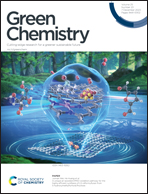Review and perspectives on carbon-based electrocatalysts for the production of H2O2via two-electron oxygen reduction
Abstract
As a versatile and environmentally friendly chemical, hydrogen peroxide (H2O2) is in high demand. The current anthraquinone oxidation process suffers from high energy consumption in hydrogen production and the cumbersome alternating operations of hydrogenation and oxidation. The direct synthesis of H2O2 from H2 and O2 is constrained by the balance between safety and efficiency and heavy metal pollution from catalysts. Two-electron oxygen reduction reaction (2e− ORR) is an efficient, safe, and low-cost route for the production of H2O2. This 2e− ORR pathway has potential to become a supplement to the anthraquinone process because of fossil energy-free feature. The bottleneck of the industrialization of 2e− ORR is the lack of efficient catalysts. The 2e− ORR catalytic performance of noble metal electrode materials urgently needs to be significantly enhanced by smart design. However, the high price and limited reserves of these noble metal-based materials still severely limit their commercialization. Among many 2e− ORR catalysts, carbon-based catalysts have received much attention because of their low cost and diverse structures. This study reviews the research progress and the synthesis methods of carbon-based catalysts for 2e− ORR in recent years. First, this paper introduces the fundamental mechanism of H2O2 production by 2e− ORR through a combination of theory and experiment. Then, the synthesis methods and optimization strategies of various high-efficiency carbon-based catalysts are discussed. Finally, the various influencing factors (pH effect, pore structure, and carbon defects) and the practical applications for H2O2 production are analyzed. In addition, the future research direction is also proposed to promote the development of carbon-based catalysts for 2e− ORR toward industrialization. Although carbon-based catalysts display obvious advantages for electrocatalytic applications, there are still a few shortcomings that need to be overcome. The intrinsic activity and the long-term stability of carbon-based materials still require to be improved to a level that can be compared with those of noble metal-based catalysts. This review presents a comprehensive overview of the latest developments in the production of H2O2 by 2e− ORR on carbon-based catalysts, combining the most advanced theoretical and experimental literature available. The current state of the research on carbon-based catalysts in recent years indicates great promise for further advancement.

- This article is part of the themed collection: 2023 Green Chemistry Reviews


 Please wait while we load your content...
Please wait while we load your content...